Summary: in this tutorial, you will learn how to use the SQL COUNT function to get the number of items in a group.
Introduction to SQL COUNT function
The SQL COUNT function is an aggregate function that returns the number of rows returned by a query. You can use the COUNT function in the SELECT statement to get the number of employees, the number of employees in each department, the number of employees who hold a specific job, etc.
The following illustrates the syntax of the SQL COUNT function:
COUNT([ALL | DISTINCT] expression);Code language: SQL (Structured Query Language) (sql)The result of the COUNT function depends on the argument that you pass to it.
- The
ALLkeyword will include the duplicate values in the result. For example, if you have a group (1, 2, 3, 3, 4, 4) and apply theCOUNTfunction, the result is 6. By default, theCOUNTfunction uses theALLkeyword whether you specify it or not. - The
DISTINCTkeyword counts only unique values. For example, theCOUNTfunction returns 4 if you apply it to the group (1, 2, 3, 3, 4, 4). - The expression is a column of a table where you want to count the value.
Another form of the COUNT function that accepts an asterisk (*) as the argument is as follows:
COUNT(*)Code language: SQL (Structured Query Language) (sql)The COUNT(*) function returns the number of rows in a table in a query. It counts duplicate rows and rows that contain null values.
SQL COUNT function examples
Let’s take some examples to see how the COUNT function works. We will use the employees table in the sample database for demonstration purposes:
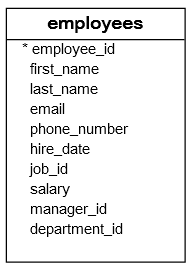
SQL COUNT(*) examples
The following example uses the COUNT(*) function to get the number of rows from the employees table:
SELECT
COUNT(*)
FROM
employees;Code language: SQL (Structured Query Language) (sql)The following example uses the COUNT(*) function to count employees who work in the department with id 6:
SELECT
COUNT(*)
FROM
employees
WHERE
department_id = 6;Code language: SQL (Structured Query Language) (sql)In this example:
- First, the
WHEREclause filter department with id 6. - Second, the
COUNT(*)function returns the number of rows from theemployeestable with the value in the department id 6.
The following example uses the COUNT(*) function to get the number of employees with the job id 9:
SELECT
COUNT(*)
FROM
employees
WHERE
job_id = 9;Code language: SQL (Structured Query Language) (sql)How it works.
- First, the
WHEREclause includes the rows from theemployeestable with the job id 9. - Second, the
COUNT(*)returns the number of rows from theemployeestable with the job id 9
The following example uses the AS keyword to assign the COUNT(*) a column alias:
SELECT
COUNT(*) as employee_count
FROM
employees
WHERE
job_id = 9;Code language: JavaScript (javascript)SQL COUNT with GROUP BY clause examples
The following example uses the COUNT function with GROUP BY clause to find the number of employees for each department:
SELECT
department_id,
COUNT(*)
FROM
employees
GROUP BY
department_id;Code language: SQL (Structured Query Language) (sql)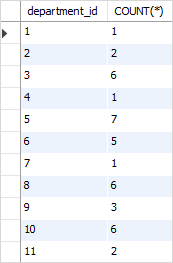
How it works:
- First, the
GROUP BYclause groups the rows in theemployeestable by the department id. - Second, the
COUNT(*)function returns the number of rows for each group
The following example uses the COUNT(*) function to get the number of employees by department. Also, it uses an INNER JOIN clause to include the department name in the result set:
SELECT
e.department_id,
department_name,
COUNT(*)
FROM
employees e
INNER JOIN departments d
ON d.department_id = e.department_id
GROUP BY
e.department_id,
department_name;Code language: SQL (Structured Query Language) (sql)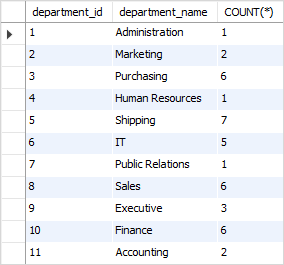
SQL COUNT(*) with ORDER BY clause example
The following example uses the ORDER BY clause to sort the number of employees by department:
SELECT
e.department_id,
department_name,
COUNT(*)
FROM
employees e
INNER JOIN departments d ON d.department_id = e.department_id
GROUP BY
e.department_id
ORDER BY
COUNT(*) DESC;Code language: SQL (Structured Query Language) (sql)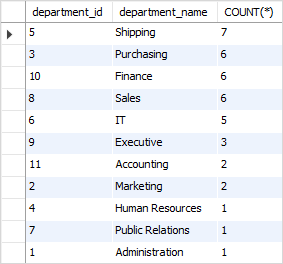
SQL COUNT with HAVING clause example
The following example returns the number of employees by department. Also, it uses a HAVING clause to select only departments that have more than five employees:
SELECT
e.department_id,
department_name,
COUNT(*)
FROM
employees e
INNER JOIN departments d ON d.department_id = e.department_id
GROUP BY
e.department_id
HAVING
COUNT(*) > 5
ORDER BY
COUNT(*) DESC;Code language: SQL (Structured Query Language) (sql)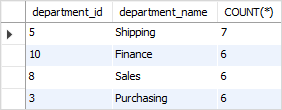
SQL COUNT(DISTINCT expression) example
The following example uses the COUNT to get the number of values in the job_id column in the employees table:
SELECT
COUNT(job_id)
FROM
employees;Code language: SQL (Structured Query Language) (sql)
The query returns 40 which includes the duplicate values. To remove the duplicates, you use the DISTINCT keyword to the COUNT function as follows:
SELECT
COUNT(DISTINCT job_id)
FROM
employees;
The following example uses the COUNT function with the DISTINCT keyword to get the number of managers:
SELECT
COUNT(DISTINCT manager_id)
FROM
employees;Code language: SQL (Structured Query Language) (sql)
Summary
- The
COUNTfunction returns the number of rows in a group. - The
ALLkeyword includes duplicate values while theDISTINCTkeyword removes the duplicate values in the result. - The
COUNT(*)returns the number of rows in a query including duplicate rows and rows that contain null values.